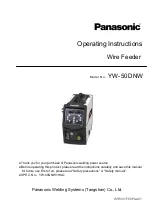
11
EN
The wirefeeder must be connected up to the power source by means of the intercon-
necting cable.
NOTE!
When using 70 m (229.66 ft. 7.91 in.) hosepacks that you have
prepared yourself or purchased from other manufacturers:
-
make sure that the cross-sectional area of the supply cables for the
wirefeeder drive is at least 13 mm² (0.02 sq.in.)
1. Shift the mains switch of the power source into the “0” position
2. Insert the strain-relief device into the opening in the wirefeeder, and fix it in place
NOTE!
Where the strain-relief device is subjected to heavy loading, screw it
firmly to the wirefeeder. For 1.2 m (3.9 ft.) long interconnecting cables, no
strain-relief device is provided.
3.
Plug the gas hose of the interconnecting cable to the "Shielding-gas" socket
4.
Tighten the swivel nut of the gas hose
5.
Screw the water forward-flow and return-flow hoses of the interconnecting cable to
the screw-type connectors and, red-to-red and black-to-black
6.
Tighten the swivel nuts of the water forward-flow and return-flow hoses
7.
Plug the LocalNet plug of the interconnecting cable into the LocalNet connection
socket
8.
Tighten the swivel nut of the LocalNet plug
9.
Plug the “Welding potential” bayonet plug of the interconnecting cable to socket
10. Twist the “Welding potential” bayonet plug to latch it into place.
NOTE!
When mounting the
cables and hoses of the
interconnecting cable, these
should be carefully looped
towards the inside, in order to
prevent wear-and-tear
Fig.10 Cables and hoses “looped towards the
inside”
Connecting up the wirefeeder to the power source
General remarks
Connecting up
the wirefeeder to
the power source
Fig.11 Connecting up the interconnecting cable to the wirefeeder
“Wirefeeder end” of intercon-
necting cable
red
blue

































